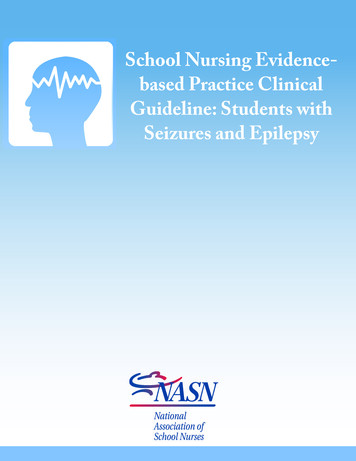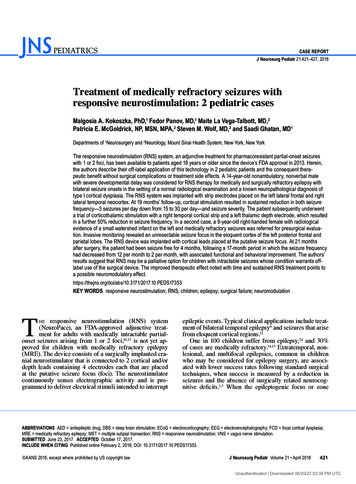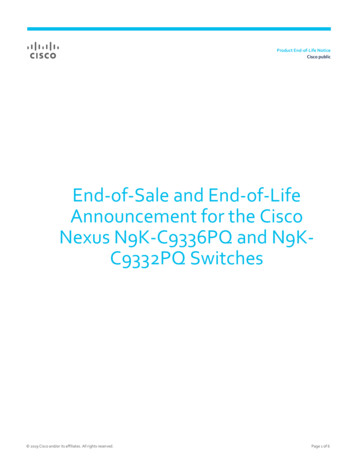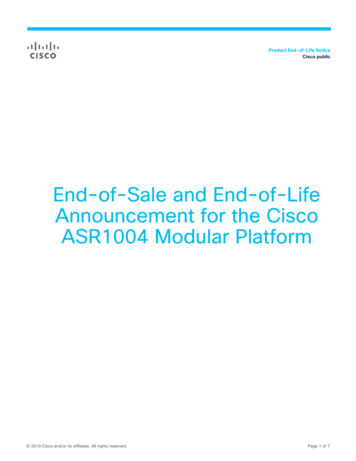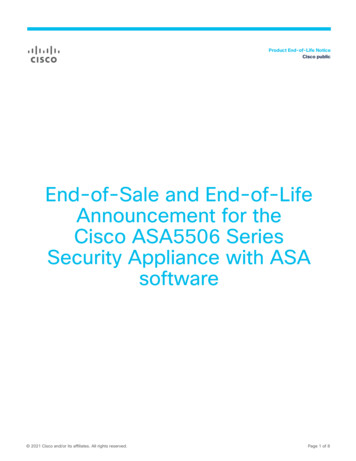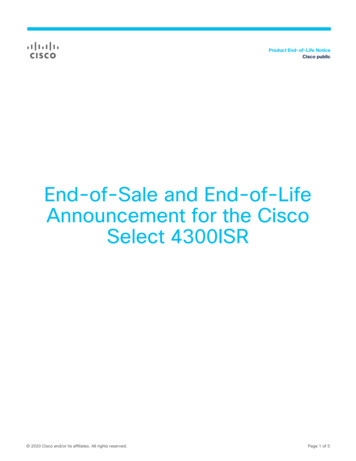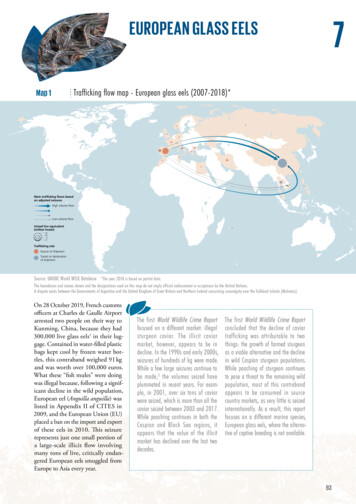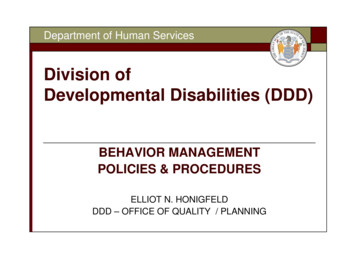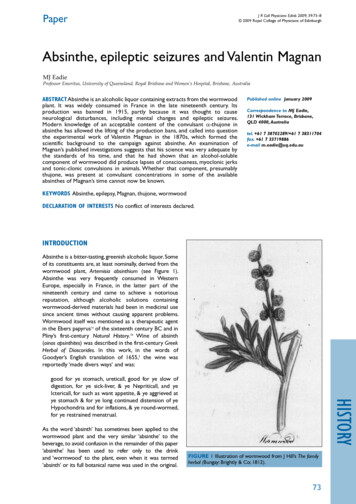Transcription
Anticonvulsants and Rectal Use: Best Practices April 2021SEIZURES AT END OF LIFE: AN OVERVIEWSeizures are a rare but serious complication at end of life. The incidence of seizure occurrence in hospicepatients is not known. Patients at an increased risk for seizures are those with brain cancer,cerebrovascular disease, metabolic abnormalities, certain genetic disorders and/or pre-existing seizuredisorders.1 Anticonvulsant therapy should continue, if possible, for patients with a history of seizures,brain tumors with experience of seizures, or a history of status epilepticus.Up to 40% of patients with brain tumors have a seizure at the time of diagnosis. Another 20%develop seizures during the course of the illness. In the past, anticonvulsants were commonlystarted at the time of brain tumor diagnosis, however they have not been found to preventseizures. Guidelines published by the American Academy of Neurology do not support seizureprophylaxis. Based on the lack of evidence for benefit, anticonvulsants can be safelydiscontinued in patients with brain tumors who have never had a seizure.1,2Most acute seizures are short-lived and terminate spontaneously. The exceptionis status epilepticus (SE), defined as a crisis in which seizure activity is abnormal,prolonged and refractory to management. Guidelines for managing SE recommendthe use of intravenous medications and suggest that neurological, respiratory andcardiovascular monitoring be available. Considering many hospice patients reside athome, these resources may not always be available or easily accessible. In addition,many patients on maintenance therapy may lose the ability to swallow reliably. Theability to administer medication via alternate routes is important to avoid hospital orhospice IPU admission for seizure management.3INDICATIONS FOR RECTAL ROUTE FOR DRUG ADMINISTRATION Intractable nausea and vomitingGI obstructionDysphagiaEsophageal stricture or malignancyLoss of consciousnessRefusing oral medications or spitting out tablets04132021Enclara Pharmacia 20211
ADVANTAGES OF THE RECTAL ROUTE Avoiding painful injectionsAdministration of drugs that don’t have a SUBCUT/IM/IV dosage formAbility to continue treatment with medications essential to comfortLIMITATIONS OF THE RECTAL ROUTE Not all drugs are absorbed rectally4Tablets and capsules administered rectally may vary in how they dissolve. It depends onpresence of stool in the rectum and hydration status.Suppositories may be expelled prematurely and not provide the total drug doseThe patient and family/caregiver may have concerns regarding the patient’s privacy or feelembarrassed by rectal administrationRECTAL ABSORPTION: SUPPORTING LITERATURE OR LACK THEREOFThe diazepam gel preparation (Diastat ) is the only commercially available rectal formulation approvedfor seizures. Several studies found effective the use of diazepam solution for injection and compoundeddiazepam suppositories administered rectally.5-12There is evidence of feasibility of short-term substitution per rectum (PR) for: Carbamazepine (Tegretol )13-18Lamotrigine (Lamictal )19,20Levetiracetam (Keppra )21,22Phenobarbital23-29Topiramate (Topamax )30Valproic acid (Depakene )31-42Limited evidence suggests PR is not an effective route for: Clonazepam (Klonopin )43-48Felbamate (Felbatol )49Gabapentin (Neurontin )50Lorazepam (Ativan ) 50-52Midazolam (Versed )50,53-62Oxcarbazepine (Trileptal )63-66Phenytoin (Dilantin )50,67-7004132021Enclara Pharmacia 20212
No evidence exists to support nor refute the PR route for: Brivaracetam (Briviact )Divalproex (Depakote )Eslicarbazepine (Aptiom )Ethosuximide (Zarontin )Ezogabine (Potiga )Lacosamide (Vimpat )Perampanel (Fycompa )Pregabalin (Lyrica )Primidone (Mysoline )Rufinamide (Banzel )Tiagabine (Gabitril )Vigabatrin (Sabril )Zonisamide (Zonegran )In patients receiving anticonvulsants for managing seizure disorders, maintaining therapeuticconcentrations of the drug is necessary for optimal seizure control.4 When literature does not supportrectal administration in humans, or literature does not exist, consider using an alternative route ofadministration or a medication with more supporting evidence. However, in the absence of literature,one can consider trying rectal administration of a drug based on the following properties: 4 Surface area of absorptionRectal retention timeAbsorption rate, considering lipid solubility of drug and the amount of nonionized drug at siteTime available for rectal drug release/drug dissolutionFor additional guidance on the use of the rectal route in palliative care, access this open access article:Samala RV, Davis M. PCNOW Fast Facts and Concepts #229: Palliative Care Per Rectum. November 2015.Article linkConsider reviewing the following past cases as topic refreshers and supplements:Rectal Administration and the Macy CatheterAcute Seizure Management04132021Enclara Pharmacia 20213
REFERENCES:1.Connelly J, Weissman D. Fast Facts and Concepts #229. Seizure management in the dying patient. June 2018.Article link2.Glantz MJ, Cole BF, Forsyth PA, et al. Practice parameter: Anticonvulsant prophylaxis in patients with newlydiagnosed brain tumors: report of the Quality Standards Subcommittee of the American Academy ofNeurology. Neurol. 2000; 54:1886-18933.Droney J, Hall E. Status epilepticus in a hospice inpatient setting. J Pain Symptom Manage. 2008; 36(1): 97-105.4.Anderson GD, Saneto RP. Current oral and non-oral routes of antiepileptic drug delivery. Adv Drug Del Rev.2012;54:911-918.5.Moolenaar F, et al. Biopharmaceutics of rectal administration of drugs in man IX. Comparativebiopharmaceutics of diazepam after single rectal, oral, and intravenous administration in man. Inter JPharmaceutics. 1980 Apr;5(2): 127-137.6.Calderon Gonzalez R. Emergency management of convulsions and prevention of status epilepticus with rectaldiazepam administered by parents. Boletin medico del Hospital Infantil de Mexico. 1991;48(7):469-473.7.Dhillon S, Ngwane E, Richens A. Rectal absorption of diazepam in epileptic children. Arch Dis Child.1982;57(4):264-267.8.Dhillon S, Oxley J, Richens A. Bioavailability of diazepam after intravenous, oral and rectal administration inadult epileptic patients. Br J Clin Pharmacol. 1982;13(3):427-432.9.Kanto J. Plasma concentrations of diazepam and its metabolites after per oral, intramuscular, and rectaladministration. Correlation between plasma concentration and sedatory effect of diazepam. Int J ClinPharmacol Biopharm. 1975;12(4):427-432.10. Knudsen FU. Plasma-diazepam in infants after rectal administration in solution and by suppository. ActaPaediatr Scand. 1977;66(5):563-567.11. Knudsen FU. Rectal administration of diazepam in solution in the acute treatment of convulsions in infants andchildren. Arch Dis Child. 1979;54(11):855-857.12. Milligan NM, et al. A clinical trial of single dose rectal and oral administration of diazepam for the preventionof serial seizures in adult epileptic patients. J Neurol Neurosurg Psychiatry. 1984;47(3):235-240.13. Arvidsson J, Nilsson HL, Sandstedt P, Steinwall G, Tonnby B, Flesch G. Replacing carbamazepine slow-releasetablets with carbamazepine suppositories: a pharmacokinetic and clinical study in children with epilepsy. JChild Neurol. 1995;10(2):114-117.14. El-Kamel A, El-Khatib M. Thermally reversible in situ gelling carbamazepine liquid suppository. Drug Deliv.2006;13(2):143-148.15. Neuvonen PJ, Tokola O. Bioavailability of rectally administered carbamazepine mixture. Br J Clin Pharmacol.1987;24(6):839-841.16. Graves NM, et al. Relative bioavailability of rectally administered carbamazepine suspension in humans.Epilepsia. 1985;26(5):429-433.04132021Enclara Pharmacia 20214
17. Graves NM, Kriel RL. Rectal administration of antiepileptic drugs in children. Pediatr Neurol. 1987;3(6):321326.18. Storey P, Trumble M. Rectal doxepin and carbamazepine therapy in patients with cancer. N Engl J Med.1992;327(18):1318-1319.19. Birnbaum AK, et al. Rectal absorption of lamotrigine compressed tablets. Epilepsia. 2000;41(7):850-853.20. Birnbaum AK, et al. Relative bioavailability of lamotrigine chewable dispersible tablets administered rectally.Pharmacother. 2001;21(2):158-162.21. Davis MP, et al. Symptom control in cancer patients: The clinical pharmacology and therapeutic role ofsuppositories and rectal suspensions. Support Care Cancer. 2002 Mar;10(2):117-38.22. Dunteman E. Levetiracetam administered by the rectal route is effective in treating neuropathic pain. J Pain2004;5(3):S50.23. Moolenaar F, Koning B, Huizinga T. Biopharmaceutics of rectal administration of drugs in man: Absorption rateand bioavailability of phenobarbital and its sodium salt from rectal dosage forms. Inter JPharmaceutics.1979;4:99-109.24. Graves, et al. Relative Bioavailability of rectally administered phenobarbital sodium parenteral solution. AnnPharmacotherapy. 1989 July/Aug;23:565-56825. Graves NM, et al. Relative bioavailability of rectally administered phenobarbital sodium parenteral solution.Dicp. 1989;23(7-8):565-568.26. Heimann G, Neuwald F, Gladtke E. Rectal absorption of phenobarbital in children as affected by differentvehicles. Arzneimittelforschung. 1978;28(6):1023-1026.27. Matsukura M, et al. Bioavailability of phenobarbital by rectal administration. Pediatr Pharmacol (New York).1981;1(3):259-265.28. Minkov E, et al. Biopharmaceutical investigation of rectal suppositories. Part 2: Pharmaceutical and biologicalavailability of phenobarbital and phenobarbital-sodium. Pharmazie. 1985;40(4):257-259.29. Yukawa E, et al. Population pharmacokinetic investigation of phenobarbital by mixed effect modelling usingroutine clinical pharmacokinetic data in Japanese neonates and infants. J Clin Pharm Ther. 2005;30(2):159163.30. Conway JM, et al. Relative bioavailability of topiramate administered rectally. Epilepsy Res. 2003;54(2-3):9196.31. Battino D, et al. Comparison of the effectiveness of several formulations of sodium valproate: Tablets, entericcoated capsules, solutions and rectal capsules. Ital J Neurol Sci. 1982;3(3):197-200.32. Cloyd JC, Kriel RL. Bioavailability of rectally administered valproic acid syrup. Neurology. 1981;31(10):13481352.33. Holmes GB, et al. Absorption of valproic acid suppositories in human volunteers. Arch Neurol. 1989;46(8):906909.34. Issakainen J, Bourgeois BF. Bioavailability of sodium valproate suppositories during repeated administration atsteady state in epileptic children. Eur J Pediatr. 1987;146(4):404-407.04132021Enclara Pharmacia 20215
35. Kanazawa O, Sengoku A, Kawai I. Treatment of childhood epilepsy with rectal valproate: case reports andpharmacokinetic study. Brain Dev. 1987;9(6):615-620.36. Matsumura S, Shima T, Okada Y, et al. Serum concentration of valproic acid after rectal administration. NeurolMed Chir (Tokyo). 1988;28(5):473-476.37. Moolenaar F, Greving WJ, Huizinga T. Absorption rate and bioavailability of valproic acid and its sodium fromrectal dosage forms. Eur J Clin Pharmacol. 1980;17(4):309-315.38. Scanabissi E, et al. Rectal administration of sodium valproate in children. Ital J Neurol Sci. 1984;5(2):189-193.39. Thorpy MJ. Rectal valproate syrup and status epilepticus. Neurology. 1980;30(10):1113-.40. Vajda FJE, et al. Rectal administration of sodium valproate in status epilepticus. Neurology. 1978;28(9):897899.41. Vajda FJE, Symington GR, Bladin PF. Rectal valproate in intractable status epilepticus. Lancet. 1977:359-360.42. Yoshiyama Y, Nakano S, Ogawa N. Chronopharmacokinetic study of valproic acid in man: comparison of oraland rectal administration. J Clin Pharmacol.1989;29(11):1048-1052.43. Netter JC, et al. Intrarectal clonazepam in children. Plasma and CSF levels. Pediatrie (Bucur). 1988;43(7):603605.44. Klosterskov Jensen P, Abild K, Nohr Poulsen M. Serum concentration of clonazepam after rectaladministration. Acta Neurol Scand. 1983;68(6):417-420.45. Rylance GW, Poulton J, Cherry RC, Cullen RE. Plasma concentrations of clonazepam after single rectaladministration. Arch Dis Child. 1986;61(2):186-188.46. Woody RC, Laney SM. Rectal anticonvulsants in pediatric practice. Pediatr Emerg Care. 1988;4(2):112-116.47. Mpimbaza A, et al. Comparison of buccal midazolam with rectal diazepam in the treatment of prolongedseizures in Ugandan children: a randomized clinical trial. Pediatrics. 2008;121:e58–e64.48. Scott RC, et al. Buccal midazolam and rectal diazepam for treatment of prolonged seizures in childhood andadolescence: A randomised trial. Lancet. 1999;353: 623–626.49. Grossmann R, Maytal J, Fernando J. Rectal administration of felbamate in a child with Lennox–Gastautsyndrome. Neurology. 1994; 44:1979.50. Kriel RL, et al. Failure of absorption of gabapentin after rectal administration. Epilepsia. 1990;38:1242-1244.51. Appleton R, et al. Lorazepam versus diazepam in the acute treatment of epileptic seizures and statusepilepticus. Dev Med Child Neurol. 1995 Aug;37(8):682-8.52. Mitchell WG, Crawford TO. Lorazepam is the treatment of choice for status epilepticus. J Epilepsy. 1990;3(1):710.53. Aydintug YS, Okcu KM, Guner Y, Gunaydin Y, Sencimen M. Evaluation of oral or rectal midazolam as conscioussedation for pediatric patients in oral surgery. Mil Med. 2004; 169(4):270-273.54. Clausen TG, et al. Pharmacokinetics of midazolam and alpha-hydroxy-midazolam following rectal andintravenous administration. Br J Clin Pharmacol. 1988;25(4):457-463.04132021Enclara Pharmacia 20216
55. Houi N, et al. Premedication with midazolam in infants. A comparison of different modes of administration.Cah Anesthesiol. 1992;40(3):167-170.56. Khazin V, Ezra S, Cohen A. Comparison of rectal to intranasal administration of midazolam for premedicationof children. Mil Med. 1995;160(11):579-581.57. Kogan A, et al. Premedication with midazolam in young children: a comparison of four routes ofadministration. Paediatr Anaesth. 2002;12(8):685-689.58. Krafft TC, et al. Experience with midazolam as sedative in the dental treatment of uncooperative children. JDent Child. 1993;60(4-5):295-299.59. Lejus C, et al. Midazolam for premedication in children: nasal vs. rectal administration. Eur J Anaesthesiol.1997;14(3):244-249.60. Malinovsky JM, et al. Plasma concentrations of midazolam after i.v., nasal or rectal administration in children.Br J Anaesth. 1993;70(6):617-620.61. Malinovsky JM, et al. Premedication with midazolam in children. Effect of intranasal, rectal and oral routes onplasma midazolam concentrations. Anaesthesia. 1995;50(4):351-354.62. Pohl B, Schmicker F, Hofmockel R. Oral and rectal premedication of children with midazolam. AnaesthesiolReanim. 2002;27(3):60-67.63. Clemens PL, et al. Relative bioavailability, metabolism and tolerability of rectally administered oxcarbazepinesuspension. Clinical Drug Investigation. 2007;27(4):243-250.64. van der Kuy PH, Koppejan EH, Wirtz JJ. Rectal absorption of oxcarbazepine. Pharm World Sci. 2000;22(4):165166.65. Brouard A, et al. Rectal administration of carbamazepine gel. Clin. Pharm.1990; 9:13–14.66. Johannessen SI, et al. Serum concentration profile studies of tablets and suppositories of valproate andcarbamazepine in healthy subjects and patients with epilepsy. In: R. Levy, et al (eds.), Metabolism ofAntiepileptic Drugs, Raven Press, New York, 1984, pp. 61–71.67. Burstein AH, et al. Absorption of phenytoin from rectal suppositories formulated with a polyethylene glycolbase. Pharmacother. 2000;20(5):562-567.68. Chang SW, da Silva JH, Kuhl DR. Absorption of rectally administered phenytoin: a pilot study. AnnPharmacother. 1999;33(7-8):781-786.69. Kerr D. Re: Practical use of rectal medications in palliative care. J Pain Symptom Manage. 1997;13(5):250.70. Moolenaar F, et al. Manipulation of rectal absorption rate of phenytoin in man. Pharm World Sci.1981;3(1):1051-1056.04132021Enclara Pharmacia 20217
Pediatrics. 2008;121:e58-e64. 48. Scott RC, et al. Buccal midazolam and rectal diazepam for treatment of prolonged seizures in childhood and adolescence: A randomised trial. Lancet. 1999;353: 623-626. 49. Grossmann R, Maytal J, Fernando J. Rectal administration of felbamate in a child with Lennox-Gastaut
